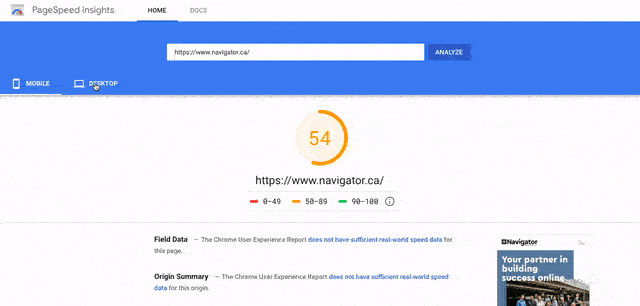Understanding Website Speed & How It Impacts Your Online Success

Website speed can make or break the success of your online presence. When your website is too slow, you risk users becoming impatient and abandoning your site. Online users expect your website to perform quickly. This means that a negative online experience reflects badly on your entire business. Here’s a quick guide to keep your website from getting left behind!
What is Website Speed?
Your website’s performance begins when a user clicks the link to access to your website. In his Shopify article, author Thomas Kelly outlines the steps the browser (Chrome, Safari, Edge, Firefox) takes to connect the user to your website. To begin, the browser registers that the user wants to connect with your website, next it determines the most efficient route to your website’s server, and finally it loads your webpage for the user to view. Loading your webpage is the user’s first (and lasting!) impression of your online presence — a fast website ensures that impression is positive.
According to a Moz-published article on page speed, there is a clear difference between page speed and website speed; the article clarifies that page speed is the rate a webpage loads its content for the user to view and website speed is the page speed of multiple pages on your website. If some webpages load fast, but others are slow, then it can affect how you score on website speed.
The Impact of Speed On Your Website:
Google Search Results
In a Forbes article about Google ranking factors, author Jia Wertz noted that Google uses over 250 ranking factors to ensure their searches are producing accurate, professional results. According to Wertz website speed is one of the most important factors that Google considers in its algorithm. Having a slower website speed can affect how high your website will score in Google search engine results. The lower your website appears in the search results, the less likely it will get clicked!
User Experience and Spending
Modern online shoppers are all too familiar with waiting for the loading pinwheel, particularly the frustration that accompanies it. Website speed is an essential aspect that can affect the user’s experience, especially for users who are connecting using their mobile device.
Recently, there has been a shift in device usage and mobile users make up the majority of a web traffic for a website. However, there are several difficulties that slow down online browsing for mobile. These users are often on slower mobile networks to support their connection, yet mobile users expect websites to perform just as quickly. In recent research 46% of people indicated that waiting for a longer period was their biggest dislike of using mobile web browsing. Longer wait times increase the likelihood of a user to abandon your website before even accessing the content. Even if a user does wait it out, it still impacts their overall opinion of your business, as 79% of online shoppers who experienced website issues claimed that they wouldn’t return.
On the flip side, having faster website speed was associated with users staying on a website longer and ultimately, more revenue in sales.
Why Are Some Websites fast, and Others Slow?
There are several factors you can consider to ensure your website is functioning at optimal speed:
- Where Your Website is Hosted. Viewing a website requires it to load through a server, having your server closer to your users allows them to access your webpage faster. Content Distribution Networks use a network of servers to store your website in multiple data centre locations which allows users in different areas to access the site more quickly and reliability. If you’re looking to change host providers, Navigator offers secure, reliable Web Hosting.
- How Your Website Code is Written. Clean and concise code is essential to ensure that your website is functioning as efficiently as possible. To achieve this, it is necessary to cut out any repeated coding. You can slim down coding by transferring parts of javascript and cascading stylesheets (CSS) rules to an external file, which requires a single download rather than repetitively loading the same code.
- Cut Back on Rich Media Sources. Media such as video backgrounds can slow down the load speed of your website. Video assets can often take 2-8+ seconds to load depending on how the video is embedded, its quality and duration. Image files should be sized appropriately and web-friendly formats should be used. For example, converting .PNG images to .JPG wont compromise image quality and can make a significant difference on file size. Google recommends using next-gen file formats like JPEG 2000, JPEG XR, and WebP whenever possible to reduce the image file size further.
- Limit Content Feed From External Sources. Pulling information from external sources, such as newsfeeds, webcams, or embedded maps, slow down the loading process. Consider cutting down on non-essential sources to boost website speed. If you keep external source content, consider placement, such as avoiding the header or footer where it requires repeated loading.
- Use a Browser Cache. When a user first visits your website, the browser can store information; this decreases load time as the website doesn’t need to reload fresh information for each visit. Neil Patel recommends using a WordPress Plugin, such as WP Super Cache to increase your page speed.
- Avoid Excessive Tags. Website tags allow third party sources to collect information about how users are interacting with that website, however, each tag requires code which slows down page speed. Google Tag Manager is an effective tool to organize and manage your website tags, including cutting out repetitive or non-essential tags.
Concerned Your Website is Slow?

Here are three common tools that you can use to check the speed of your website:
Unhappy with your results? Contact us at Navigator and get a free quote to speed up your website!


